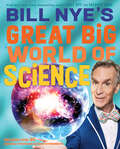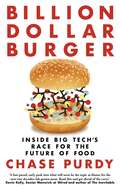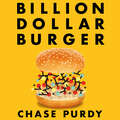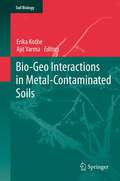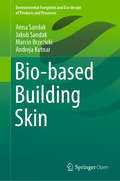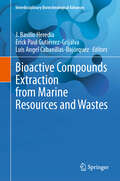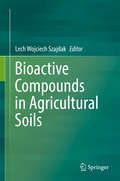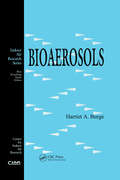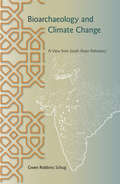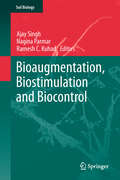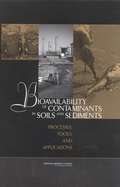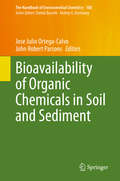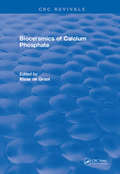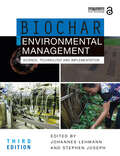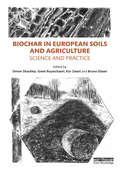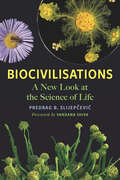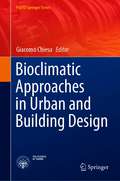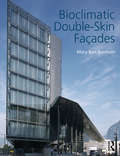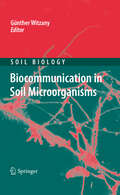- Table View
- List View
Bill Nye's Great Big World of Science
by Bill Nye Gregory MoneWith photos, experiments, and more, this “appealing and highly informative” science book from the beloved TV host is “a winner” (School Library Journal).Science educator, TV host, and New York Times–bestselling author Bill Nye is on a mission to help young people understand and appreciate the science that makes our world work. Featuring a range of subjects—physics, chemistry, geology, biology, astronomy, global warming, and more—this profusely illustrated book covers the basic principles of each science, key discoveries, recent revolutionary advances, and the problems that science still needs to solve for our Earth. Nye and coauthor Gregory Mone present the most difficult theories and facts in an easy-to-comprehend, humorous way. They interviewed numerous specialists from around the world, in each of the fields discussed, whose insights are included throughout. Also included are experiments kids can do themselves to bring science to life! “Wordplay and wry wit put extra fun into a trove of fundamental knowledge.” —Kirkus Reviews (starred review) Includes photographs, illustrations, diagrams, glossary, bibliography, and index
Billion Dollar Burger: Inside Big Tech's Race for the Future of Food
by Chase PurdyA fast-paced, gripping insider account of the entrepreneurs and renegades racing to bring lab-grown meat to the world.The trillion-dollar meat industry is one of our greatest environmental hazards; it pollutes more than all the world's fossil-fuel-powered cars. Global animal agriculture is responsible for deforestation, soil erosion and more emissions than air travel, paper mills and coal mining combined. It also depends on the slaughter of more than 60 billion animals per year, a number that is only increasing as the global appetite for meat swells. The whole world seems to be sleepwalking into a food crisis. But a band of doctors, scientists, activists and entrepreneurs have been racing to end animal agriculture as we know it, hoping to fulfill a dream of creating meat without ever having to kill an animal. This is the story of a group of seven vegans quietly working to solve one the most pressing issues we face today, creating the biggest upheaval to the food business in decades along the way. In Billion Dollar Burger, Chase Purdy explores the companies at the cutting edge of the nascent food technology sector, from polarizing activist-turned-tech CEO Josh Tetrick to lobbyists and regulators on both sides of the issue. Billion Dollar Burger follows the people fighting to upend our food system as they butt up against the entrenched interests fighting viciously to stop them. It will take readers on a truly global journey from Silicon Valley to China, by way of Israel and the UK.The stakes are monumentally high: cell-cultured meat is the best hope for sustainable food production, a key to fighting climate change, a gold mine for the companies that make it happen and an existential threat for the farmers and meatpackers that make our meat today.
Billion Dollar Burger: Inside Big Tech's Race for the Future of Food
by Chase PurdyA fast-paced, gripping insider account of the entrepreneurs and renegades racing to bring lab-grown meat to the world.The trillion-dollar meat industry is one of our greatest environmental hazards; it pollutes more than all the world's fossil-fuel-powered cars. Global animal agriculture is responsible for deforestation, soil erosion and more emissions than air travel, paper mills and coal mining combined. It also depends on the slaughter of more than 60 billion animals per year, a number that is only increasing as the global appetite for meat swells. The whole world seems to be sleepwalking into a food crisis. But a band of doctors, scientists, activists and entrepreneurs have been racing to end animal agriculture as we know it, hoping to fulfill a dream of creating meat without ever having to kill an animal. This is the story of a group of seven vegans quietly working to solve one the most pressing issues we face today, creating the biggest upheaval to the food business in decades along the way. In Billion Dollar Burger, Chase Purdy explores the companies at the cutting edge of the nascent food technology sector, from polarizing activist-turned-tech CEO Josh Tetrick to lobbyists and regulators on both sides of the issue. Billion Dollar Burger follows the people fighting to upend our food system as they butt up against the entrenched interests fighting viciously to stop them. It will take readers on a truly global journey from Silicon Valley to China, by way of Israel and the UK.The stakes are monumentally high: cell-cultured meat is the best hope for sustainable food production, a key to fighting climate change, a gold mine for the companies that make it happen and an existential threat for the farmers and meatpackers that make our meat today.
Billionaire Wilderness: The Ultra-Wealthy and the Remaking of the American West (Princeton Studies in Cultural Sociology #83)
by Justin FarrellA revealing look at the intersection of wealth, philanthropy, and conservationBillionaire Wilderness takes you inside the exclusive world of the ultra-wealthy, showing how today's richest people are using the natural environment to solve the existential dilemmas they face. Justin Farrell spent five years in Teton County, Wyoming, the richest county in the United States, and a community where income inequality is the worst in the nation. He conducted hundreds of in-depth interviews, gaining unprecedented access to tech CEOs, Wall Street financiers, oil magnates, and other prominent figures in business and politics. He also talked with the rural poor who live among the ultra-wealthy and often work for them. The result is a penetrating account of the far-reaching consequences of the massive accrual of wealth, and an eye-opening and sometimes troubling portrait of a changing American West where romanticizing rural poverty and conserving nature can be lucrative—socially as well as financially.Weaving unforgettable storytelling with thought-provoking analysis, Billionaire Wilderness reveals how the ultra-wealthy are buying up the land and leveraging one of the most pristine ecosystems in the world to climb even higher on the socioeconomic ladder. The affluent of Teton County are people burdened by stigmas, guilt, and status anxiety—and they appropriate nature and rural people to create more virtuous and deserving versions of themselves. Incisive and compelling, Billionaire Wilderness reveals the hidden connections between wealth concentration and the environment, two of the most pressing and contentious issues of our time.
Bio-Geo Interactions in Metal-Contaminated Soils (Soil Biology #31)
by Ajit Varma Erika KotheMetal contamination is an increasing ecological and eco-toxicological risk. Understanding the processes involved in metal mobilization, sorption and mineralization in soils are key features for soil bioremediation. Following an introduction to the physical, chemical and biological components of contaminated soils, various chapters address the interactions of soil, microorganisms, plants and the water phase necessary to transfer metals into biological systems. These include topics such as potential hazards at mining sites; rare earth elements in biotic and abiotic acidic systems; manganese redox reactions; biomineralisation, uranium in seepage water; metal-resistant streptomycetes; mycorrhiza in re-forestation; metal (hyper)accummulation in plants; microbial metal uptake; and their potential for bioremediation. This book will be of interest to soil biologists, geologists and chemists, researchers and graduate students, as well as consulting companies and small enterprises involved in bioremediation.
Bio-based Building Skin (Environmental Footprints and Eco-design of Products and Processes)
by Andreja Kutnar Anna Sandak Jakub Sandak Marcin BrzezickiThis book provides a compendium of material properties, demonstrates several successful examples of bio-based materials’ application in building facades, and offers ideas for new designs and novel solutions. It features a state-of-the-art review, addresses the latest trends in material selection, assembling systems, and innovative functions of facades in detail. Selected case studies on buildings from diverse locations are subsequently presented to demonstrate the successful implementation of various biomaterial solutions, which defines unique architectural styles and building functions. The structures, morphologies and aesthetic impressions related to bio-based building facades are discussed from the perspective of art and innovation; essential factors influencing the performance of materials with respect to functionality and safety are also presented. Special emphasis is placed on assessing the performance of a given facade throughout the service life of a building, and after its end. The book not only provides an excellent source of technical and scientific information, but also contributes to public awareness by demonstrating the benefits to be gained from the proper use of bio-based materials in facades. As such, it will appeal to a broad audience including architects, engineers, designers and building contractors.
Bio-based Materials for Food Packaging: Green and Sustainable Advanced Packaging Materials
by Shakeel AhmedThis book provides an overview of the lastest developments in biobased materials and their applications in food packaging. Written by experts in their respective research domain, its thirteen chapters discuss in detail fundamental knowledge on bio based materials. It is intended as a reference book for researchers, students, research scholars, academicians and scientists seeking biobased materials for food packaging applications.
Bioactive Compounds Extraction from Marine Resources and Wastes (Interdisciplinary Biotechnological Advances)
by J. Basilio Heredia Erick Paul Gutiérrez-Grijalva Luis Angel Cabanillas-BojórquezThis book provides information about the principal biotechnological strategies (enzyme-assisted extraction, liquid fermentation, and solid-state fermentation) used for the bioactive compounds (bioactive peptides, carotenoids, phenolic acids, polyunsaturated fatty acids, vitamins, and minerals, among others) extraction from the marine resource (marine animals, microalgae, seaweed, among others) and wastes (crustaceans, fish, and others). This book also highlights the importance of bioactive compounds in marine resources and wastes and the perspectives for a potential industrial application. This book is oriented to researchers related to marine resources and marine wastes, who apply their knowledge in the innovation of the extraction and application of bioactive compounds from these sources. Moreover, this book will also provide knowledge and areas of opportunity for entrepreneurs, different industries, and the development of new products that could be used in the overall improvement of different areas such as human health.
Bioactive Compounds in Agricultural Soils
by Lech Wojciech SzajdakThis volume looks at the impact that different cropping systems and tillage have on soil's biologically active substances. It considers how phytotoxins accumulate and can inhibit the development of cultivated plants. Coverage explores the continuous cropping of rye, crop rotation, no tillage, and conventional tillage. It offers a comprehensive, comparative approach to allelopathic plant-soil interactions. The authors focus on free and bounded biologically active substances such as amino acids, auxins, humic and fulvic acids, transient radicals, and enzymes in light sand soils fertilized with different mineral and organic fertilizers. The chapters address fundamental questions relevant to the environmental challenges we face today and will deal with in the future. The results involve asking basic questions motivated by soil's chemical and biochemical processes. The answers will lead to the improvement of the quality of soil's organic matter, which, in turn, can lead to increased crop yields. Readers will come to understand the relationship between ecological processes and environmental change on individual levels of biocomplexity as well as on systems in their entirety. The title is ideal for students and teachers for laboratory practical classes. Soil scientists, biochemists, chemists, plant ecophysiologists, "Natural Products" organic chemists, and other environmental scientists and specialists will also find it useful.
Bioaerosols (Indoor Air Research Ser. #2)
by Harriet A. BurgeWritten by an illustrious group of experts in microbiology and aerobiology, Bioaerosols brings together current information on the nature and health effects of bioaerosol-related problems. The book presents up-to-date coverage of methods for sampling and analysis, as well as various approaches to the investigation of health problems caused by exposure to biological contaminants in indoor air. Its comprehensive treatment of the various aspects of this subject makes it a valuable reference for industrial hygienists, public health officials and researchers, and physicians interested in environmentally caused disease.
Bioarchaeology and Climate Change: A View from South Asian Prehistory (Bioarchaeological Interpretations of the Human Past: Local, Regional, and Global)
by Gwen Robbins Schug"Using subadult skeletons from the Deccan Chalcolithic period of Indian prehistory, along with archaeological and paleoclimate data, this volume makes an important contribution to understanding the effects of ecological change on demography and childhood growth during the second millennium B.C. in peninsular India."--Michael Pietrusewsky, University of Hawai‘i at Manoa In the context of current debates about global warming, archaeology contributes important insights for understanding environmental changes in prehistory, and the consequences and responses of past populations to them. In Indian archaeology, climate change and monsoon variability are often invoked to explain major demographic transitions, cultural changes, and migrations of prehistoric populations. During the late Holocene (1400-700 B.C.), agricultural communities flourished in a semiarid region of the Indian subcontinent, until they precipitously collapsed. Gwen Robbins Schug integrates the most recent paleoclimate reconstructions with an innovative analysis of skeletal remains from one of the last abandoned villages to provide a new interpretation of the archaeological record of this period. Robbins Schug’s biocultural synthesis provides us with a new way of looking at the adaptive, social, and cultural transformations that took place in this region during the first and second millennia B.C. Her work clearly and compellingly usurps the climate change paradigm, demonstrating the complexity of human-environmental transformations. This original and significant contribution to bioarchaeological research and methodology enriches our understanding of both global climate change and South Asian prehistory.
Bioaugmentation, Biostimulation and Biocontrol (Soil Biology #10)
by Ajay Singh Ramesh C. Kuhad Nagina ParmarBioaugmentation, biostimulation and biocontrol approaches using microbial inoculants, biofertilizers, biochemicals and organic amendments improve soil biology, fertility and crop productivity by providing plant growth-promoting nutrients and suppressing soil-borne diseases and plant-parasitic nematodes. Our knowledge of microbial diversity and its function in soils has been increased tremendously due to the availability of a wealth of data gained through recent advances in the development of molecular methods and metagenomics for the evaluation of microbial diversity and functions in the rhizosphere environment of soil. Chapters dealing with the application of biofertilizers and organic amendments are contributed by experts - authorities in the area of soil science including microbiology and molecular biology - from academic institutions and the industry.
Bioavailability Of Contaminants In Soils And Sediments: Processes, Tools, And Applications
by Committee on Bioavailability of Contaminants in Soils SedimentsBioavailability refers to the extent to which humans and ecological receptors are exposed to contaminants in soil or sediment. The concept of bioavailability has recently piqued the interest of the hazardous waste industry as an important consideration in deciding how much waste to clean up. The rationale is that if contaminants in soil and sediment are not bioavailable, then more contaminant mass can be left in place without creating additional risk. A new NRC report notes that the potential for the consideration of bioavailability to influence decision-making is greatest where certain chemical, environmental, and regulatory factors align. The current use of bioavailability in risk assessment and hazardous waste cleanup regulations is demystified, and acceptable tools and models for bioavailability assessment are discussed and ranked according to seven criteria. Finally, the intimate link between bioavailability and bioremediation is explored. The report concludes with suggestions for moving bioavailability forward in the regulatory arena for both soil and sediment cleanup.
Bioavailability of Organic Chemicals in Soil and Sediment (The Handbook of Environmental Chemistry #100)
by Jose Julio Ortega-Calvo John Robert ParsonsThis book discusses bioavailability concepts and methods, summarizing the current knowledge on bioavailability science, as well as possible pathways for integrating bioavailability into risk assessment and the regulation of organic chemicals. Divided into 5 parts, it begins with an overview of chemical distribution in soil and sediment, as well as the bioavailability and bioaccumulation of chemicals in plants, soil, invertebrates and vertebrates (including humans). It then focuses on the impact of sorption processes and reviews bioavailability measurement methods. The closing chapters discuss the impact of bioavailability studies on chemical risk assessment, and highlights further research needs. Written by a multi-disciplinary team of authors, it is an essential resource for scientists in academia and industry, students, as well as for authorities.
Bioceramics Calcium Phosphate
by K. de GrootThe first chapters are fundamental, in that the physical chemistry of calcium phosphate salts is discussed, along with mineralization (with emphasis on teeth) and remodelling of mineralized tissues. Thereafter follows a treatment of the influence of implants o surrounding hard tissues. This topic is followed by a chapter on preparation methods and biomechanical and biological aspects of calcium phosphate implants. In conclusion, two chapters are devoted to (possible) dental and medical applications. It is hoped that basic researchers can use the book in their efforts to improve this promising class of materials further, and that clinicians are inspired to define further possibilities and � at least as important � limitations.
Biochar
by Bruckman Viktor J. Varol Esin Apaydın Uzun Başak B. Jay LiuClimate change poses a fundamental threat to humanity, and thus solutions for both mitigation and adaptation strategies are becoming increasingly necessary. Biochar can offer a range of environmental services, such as reclamation of degraded land, improvement of soil fertility and carbon sequestration. However, it also raises questions, regarding sustainable feedstock provision, biomass pyrolysis, and soil amendment. These questions, among various others, are addressed in this state-of-the-art compendium. Covering a broad geographical range, with regional assessments from North America, Europe, the Near East, and Southeast Asia, this interdisciplinary volume focuses on the entire biochar supply chain, from the availability and economics of biomass resources, to pyrolysis, and ultimately to the impacts on soil properties. The combination of theory with practical examples makes this a valuable book for researchers, policymakers, and graduate students alike, in fields such as soil science, sustainable development, climate change mitigation, biomass and bioenergy, forestry, and environmental engineering.
Biochar Applications in Agriculture and Environment Management
by Jay Shankar Singh Chhatarpal SinghThis book provides up-to-date information on biochar use in management of soil health, agriculture productivity, green-house gases, restoration ecology and environment. Biochar application to nutrient deficient and disturbed soils is a viable option which may promotes advances in food safety and food security to human nutrition and overall fundamental research in the agricultural sciences. The book describes in detail how the recalcitrant biochar is able to persist for long periods of time and work as a shelter for soil microbial colonisation and their biomass/numbers. This book also includes contents related to important role of biochar applications in the restoration of contaminated agricultural soils. The book will be of particular interest to students, teachers and researchers in the disciplines.
Biochar for Environmental Management: Science, Technology and Implementation
by Stephen JosephFully revised and updated for its third edition, this book presents the definitive compilation of current knowledge on all aspects of biochar.Research on biochar continues to accelerate as its importance for soil health, climate change mitigation and adoption, and the circular economy becomes more widely acknowledged. This book not only reviews recent advances made in our understanding of biochar properties, behavior, and effects in agriculture, environmental management, and material production, but specifically develops fundamental principles and frameworks of biochar science and application. This third edition has been fully revised and updated to reflect recent developments and growing trends, with important coverage of the application of biochar outside of its traditional soil-based uses, the commercialization of biochar, and its incorporation into policy. This includes brand new chapters on the role of biochar-based materials for environmental remediation, building construction, and animal feed, and a greater discussion of biochar's role in the circular economy, climate change mitigation, and sustainable development. Overall, this book provides a systematic, comprehensive, and global examination of biochar. Written by an international team of academics and professionals, it addresses its uses, production, and management and its broader potential for mitigating climate change and driving forward sustainable development.Edited by two leading figures in the field, Biochar for Environmental Management is essential reading for students, scholars, practitioners, and policymakers interested in biochar and the role it can play in environmental sustainability and global sustainable development.Chapter 16 of this book is freely available as a downloadable Open Access PDF at http://www.taylorfrancis.com under a Creative Commons Attribution-Non Commercial-No Derivatives (CC-BY-NC-ND) 4.0 license.
Biochar in European Soils and Agriculture: Science and Practice
by Simon Shackley Greet Ruysschaert Kor Zwart Bruno GlaserThis user-friendly book introduces biochar to potential users in the professional sphere. It de-mystifies the scientific, engineering and managerial issues surrounding biochar for the benefit of audiences including policy makers, landowners and farmers, land use, agricultural and environmental managers and consultants, industry and lobby groups and NGOs. The book reviews state-of-the-art knowledge in an approachable way for the non-scientist, covering all aspects of biochar production, soil science, agriculture, environmental impacts, economics, law and regulation and climate change policy. Chapters provide ‘hands-on’ practical information, including how to evaluate biochar and understand what it is doing when added to the soil, how to combine biochar with other soil amendments (such as manure and composts) to achieve desired outcomes, and how to ensure safe and effective use. The authors also present research findings from the first coordinated European biochar field trial and summarize European field trial data. Explanatory boxes, infographics and concise summaries of key concepts are included throughout to make the subject more understandable and approachable.
Biocidal
by Ted DracosIn 1962, Rachel Carson stunned the world with the publication of Silent Spring, exposing the lethal character of the pesticide DDT. Her work launched a global campaign against synthetic chemical toxins and veritably created a world environmental movement. But unbeknownst to Carson, an even more insidious chemical cousin to DDT had been silently poisoning the biosphere. Polychlorinated biphenyls (PCBs) were first manufactured in 1920. Seen as a “magic fluid,” they were a cheap and stable heat-transfer material used as a critical coolant in big power grids. The chemical industry soon went on to develop hundreds of other uses for this highly toxic group of substances—everything from copy paper and paint to hydraulic fluids. Despite being outlawed in the U.S. since 1976, PCBs are currently found in the remotest corners of Earth and remain the most prevalent group of industrial chemical contaminants in much of the world. Every human being, from the womb to the grave, bears a body burden of these poisonous molecules forever locked in their blood and tissues. In Biocidal, investigative journalist Ted Dracos tells the full story of PCBs for the first time, starting with the chilling chronicle of how the chemical industry manipulated regulatory agencies and scientific findings for decades to continue to reap huge profits, despite their knowledge of the threats posed by their “magic fluid.” Dracos draws on extensive research to document the connection between PCBs and catastrophic human illness, presenting the latest science as studies draw ever more disturbing links between PCBs and continued health impacts ranging from cancer and autism to immunosuppression and reproductive abnormalities. Biocidal also explores the science behind the threat PCBs pose to Earth’s biodiversity: today, killer whales in the Puget Sound are dying, the eggs of Ontario Lake trout are doomed before they can hatch, 99 percent of the freshwater eels of Europe have disappeared, and frogs around the world are going extinct. While these disasters have many possible causes, evidence pointing to PCBs keeps accumulating, much like the toxins in these animals’ systems. Nonetheless, Dracos leaves readers with a profound message of hope: the damage is not irreversible. In fact, cleanup efforts that involve the removal of the source of PCBs can really work, and quickly. Offering a simple blueprint for steps that can be taken to reduce the impacts of all industrial chemicals, Biocidal ultimately points the way toward a detoxified world.
Biocivilisations: A New Look at the Science of Life
by Predrag B. Slijepcevic2024 Nautilus Book Award Gold Medal Winner: Restorative Earth Practices"A brilliant book [that] shows a way out of the destructive trap of Anthropocentric arrogance."—Vandana Shiva, author of Terra Viva"An unusually thought-provoking and ambitious book."—Dr. James A. Shapiro, author of Evolution: A View from the 21st CenturyBiocivilisations is an important, original rethinking of the mystery of life and its deep uncertainty, exploring the complex civilisations that existed on Earth long before humans.What is life? Many scientists believe life can be reduced to &‘mechanistic&’ factors, such as genes and information codes. Yet there is a growing army of scientists, philosophers and artists who reject this view. The gene metaphor is not only too simplistic but deeply misleading. If there is a way to reduce life to a single principle, that principle must acknowledge the creativity of life, turning genetic determinism on its head.The term biocivilisations is the acknowledgement of this uncertainty of life, as opposed to a quasi-certainty of the human position governed by a narrow time window of the scientific revolution. Life existed without humans for more than 99.99 percent of the Earth&’s existence. Life will also continue without humans long after our inevitable extinction.In Biocivilisations, Dr Predrag Slijepčević shows how bacteria, amoebas, plants, insects, birds, whales, elephants and countless other species not only preceded human beings but demonstrate elements of how we celebrate human civilisation – complex communication, agriculture, science, art, medicine and more.Humans must try to adopt this wisdom from other biocivilisations that have long preceded our own. By rethinking the current scientific paradigm, Dr Slijepčević makes clear that a transformation – from a naïve young species into a more mature species in tune with its surroundings – will save us from our own violence and the violence we inflict on the rest of our living planet."Read this book if you would like to understand the intelligence of living systems."—Dr Denis Noble, University of Oxford
Biocivilisations: A New Look at the Science of Life
by Predrag B. Slijepčević*2024 Nautilus Book Award Gold Medal Winner: Restorative Earth Practices "A brilliant book [that] shows a way out of the destructive trap of Anthropocentric arrogance."—Vandana Shiva, author of Terra Viva "An unusually thought-provoking and ambitious book."—Dr. James A. Shapiro, author of Evolution: A View from the 21st Century Biocivilisations is an important, original rethinking of the mystery of life and its deep uncertainty, exploring the complex civilisations that existed on Earth long before humans. What is life? Many scientists believe life can be reduced to ‘mechanistic’ factors, such as genes and information codes. Yet there is a growing army of scientists, philosophers and artists who reject this view. The gene metaphor is not only too simplistic but deeply misleading. If there is a way to reduce life to a single principle, that principle must acknowledge the creativity of life, turning genetic determinism on its head. The term biocivilisations is the acknowledgement of this uncertainty of life, as opposed to a quasi-certainty of the human position governed by a narrow time window of the scientific revolution. Life existed without humans for more than 99.99 percent of the Earth’s existence. Life will also continue without humans long after our inevitable extinction. In Biocivilisations, Dr Predrag Slijepčević shows how bacteria, amoebas, plants, insects, birds, whales, elephants and countless other species not only preceded human beings but demonstrate elements of how we celebrate human civilisation – complex communication, agriculture, science, art, medicine and more. Humans must try to adopt this wisdom from other biocivilisations that have long preceded our own. By rethinking the current scientific paradigm, Dr Slijepčević makes clear that a transformation – from a naïve young species into a more mature species in tune with its surroundings – will save us from our own violence and the violence we inflict on the rest of our living planet. "Read this book if you would like to understand the intelligence of living systems."—Dr Denis Noble, University of Oxford
Bioclimatic Approaches in Urban and Building Design (PoliTO Springer Series)
by Giacomo ChiesaThis book explores the bioclimatic approach to building design. Constant innovations in the field are evident, including the need to face climate changes and increase the local resilience at different scales (regional, urban, architectural). Differently from other contributions, this book provides a definition of the bioclimatic design approach following a technological and performance-driven vision. It includes one of the largest collection of research voices on the topic, becoming also a critical reference work for bioclimatic theory. It is intended for architects, engineers, researchers, and technicians who have professional and research interests in bioclimatic and in sustainable and technological design issues.
Bioclimatic Double-Skin Façades
by Mary Ben BonhamVisually enriched with over 250 photographs and drawings, Bioclimatic Double-Skin Façades is an essential reference guide for understanding the types and functions of double-skin façades. Author Mary Ben Bonham examines the history and continuing potential of double-skin architecture, informing on the variety of approaches possible and advising a rigorous integrated design process leading to application. Featuring a wide selection of architectural examples, the book will be of interest to professionals and students within the fields of architecture, engineering, and construction. Characterized by a buffer-like air space between two glazed building skins, double-skin windows and façades aim to improve building comfort and energy performance. Double skins introduce complexity and initial costs, yet significant buildings in locations around the globe continue to select this approach. In addition to exploring motivations, benefits, and cautions for designing with double skins, the book provides a primer on fundamental façade design concepts and strategies for control of thermal, luminous, and acoustic environments. Chapters also address alternative types of high-performance façades and implications for each phase of façade design and construction. Bioclimatic Double-Skin Façades promotes bioclimatic design that is inspired by nature, measured in performance, and uniquely adapted to climate and place. In-depth case studies illustrate how double-skin façades have been adapted to a range of climates and cultural settings: Marseille Library and Grenoble Courthouse in France, Cambridge Public Library in Massachusetts, Manitoba Hydro Place in Canada, and the Pearl River Tower in China.
Biocommunication in Soil Microorganisms (Soil Biology #23)
by Günther WitzanyCommunication is defined as an interaction between at least two living agents which share a repertoire of signs. These are combined according to syntactic, semantic and context-dependent, pragmatic rules in order to coordinate behavior. This volume deals with the important roles of soil bacteria in parasitic and symbiotic interactions with viruses, plants, animals and fungi. Starting with a general overview of the key levels of communication between bacteria, further reviews examine the various aspects of intracellular as well as intercellular biocommunication between soil microorganisms. This includes the various levels of biocommunication between phages and bacteria, between soil algae and bacteria, and between bacteria, fungi and plants in the rhizosphere, the role of plasmids and transposons, horizontal gene transfer, quorum sensing and quorum quenching, bacterial-host cohabitation, phage-mediated genetic exchange and soil viral ecology.
